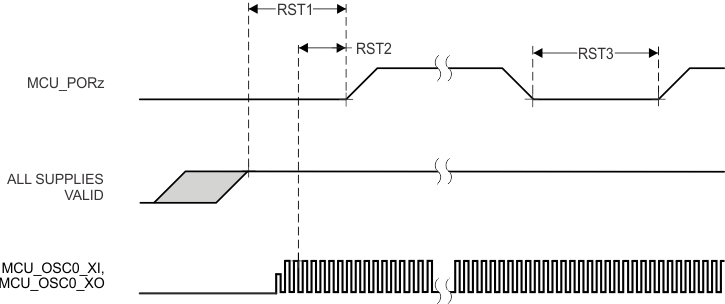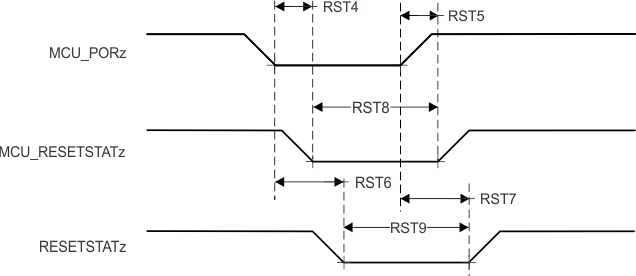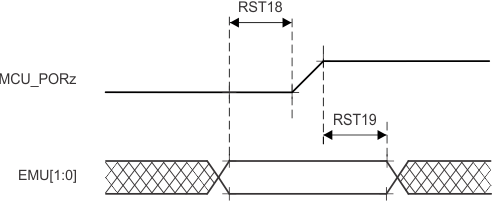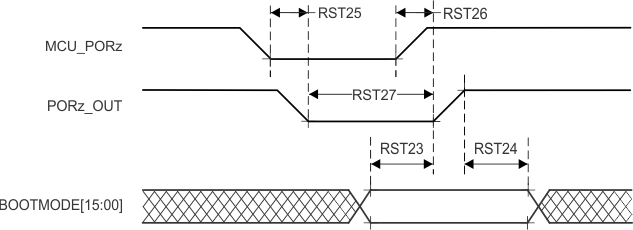SPRSP65G April 2021 – May 2024 AM2431 , AM2432 , AM2434
PRODUCTION DATA
- 1
- 1 Features
- 2 Applications
- 3 Description
- 4 Device Comparison
-
5 Terminal Configuration and Functions
- 5.1 Pin Diagram
- 5.2 Pin Attributes
- 5.3
Signal Descriptions
- 17
- 5.3.1 AM243x_ALX Package - Unsupported Interfaces and Signals
- 5.3.2 ADC
- 5.3.3 CPSW
- 5.3.4 CPTS
- 5.3.5 DDRSS
- 5.3.6 ECAP
- 5.3.7 Emulation and Debug
- 5.3.8 EPWM
- 5.3.9 EQEP
- 5.3.10 FSI
- 5.3.11 GPIO
- 5.3.12 GPMC
- 5.3.13 I2C
- 5.3.14 MCAN
- 5.3.15 SPI (MCSPI)
- 5.3.16 MMC
- 5.3.17 OSPI
- 5.3.18 Power Supply
- 5.3.19 PRU_ICSSG
- 5.3.20 Reserved
- 5.3.21 SERDES
- 5.3.22 System and Miscellaneous
- 5.3.23 TIMER
- 5.3.24 UART
- 5.3.25 USB
- 5.4 Pin Connectivity Requirements
-
6 Specifications
- 6.1 Absolute Maximum Ratings
- 6.2 ESD Ratings
- 6.3 Power-On Hours (POH)
- 6.4 Recommended Operating Conditions
- 6.5 Operating Performance Points
- 6.6 Power Consumption Summary
- 6.7
Electrical Characteristics
- 6.7.1 I2C Open-Drain, and Fail-Safe (I2C OD FS) Electrical Characteristics
- 6.7.2 Fail-Safe Reset (FS RESET) Electrical Characteristics
- 6.7.3 High-Frequency Oscillator (HFOSC) Electrical Characteristics
- 6.7.4 eMMCPHY Electrical Characteristics
- 6.7.5 SDIO Electrical Characteristics
- 6.7.6 LVCMOS Electrical Characteristics
- 6.7.7 ADC12B Electrical Characteristics (ALV package)
- 6.7.8 ADC10B Electrical Characteristics (ALX package)
- 6.7.9 USB2PHY Electrical Characteristics
- 6.7.10 SerDes PHY Electrical Characteristics
- 6.7.11 DDR Electrical Characteristics
- 6.8 VPP Specifications for One-Time Programmable (OTP) eFuses
- 6.9 Thermal Resistance Characteristics
- 6.10
Timing and Switching Characteristics
- 6.10.1 Timing Parameters and Information
- 6.10.2 Power Supply Requirements
- 6.10.3 System Timing
- 6.10.4 Clock Specifications
- 6.10.5
Peripherals
- 6.10.5.1 CPSW3G
- 6.10.5.2 DDRSS
- 6.10.5.3 ECAP
- 6.10.5.4 EPWM
- 6.10.5.5 EQEP
- 6.10.5.6 FSI
- 6.10.5.7 GPIO
- 6.10.5.8 GPMC
- 6.10.5.9 I2C
- 6.10.5.10 MCAN
- 6.10.5.11 MCSPI
- 6.10.5.12 MMCSD
- 6.10.5.13 CPTS
- 6.10.5.14 OSPI
- 6.10.5.15 PCIe
- 6.10.5.16
PRU_ICSSG
- 6.10.5.16.1 PRU_ICSSG Programmable Real-Time Unit (PRU)
- 6.10.5.16.2 PRU_ICSSG Pulse Width Modulation (PWM)
- 6.10.5.16.3 PRU_ICSSG Industrial Ethernet Peripheral (IEP)
- 6.10.5.16.4 PRU_ICSSG Universal Asynchronous Receiver Transmitter (UART)
- 6.10.5.16.5 PRU_ICSSG Enhanced Capture Peripheral (ECAP)
- 6.10.5.16.6 PRU_ICSSG RGMII, MII_RT, and Switch
- 6.10.5.17 Timers
- 6.10.5.18 UART
- 6.10.5.19 USB
- 6.10.6 Emulation and Debug
-
7 Detailed Description
- 7.1 Overview
- 7.2 Processor Subsystems
- 7.3 Accelerators and Coprocessors
- 7.4
Other Subsystems
- 7.4.1 PDMA Controller
- 7.4.2
Peripherals
- 7.4.2.1 ADC
- 7.4.2.2 DCC
- 7.4.2.3 Dual Date Rate (DDR) External Memory Interface (DDRSS)
- 7.4.2.4 ECAP
- 7.4.2.5 EPWM
- 7.4.2.6 ELM
- 7.4.2.7 ESM
- 7.4.2.8 GPIO
- 7.4.2.9 EQEP
- 7.4.2.10 General-Purpose Memory Controller (GPMC)
- 7.4.2.11 I2C
- 7.4.2.12 MCAN
- 7.4.2.13 MCRC Controller
- 7.4.2.14 MCSPI
- 7.4.2.15 MMCSD
- 7.4.2.16 OSPI
- 7.4.2.17 Peripheral Component Interconnect Express (PCIe)
- 7.4.2.18 Serializer/Deserializer (SerDes) PHY
- 7.4.2.19 Real Time Interrupt (RTI/WWDT)
- 7.4.2.20 Dual Mode Timer (DMTIMER)
- 7.4.2.21 UART
- 7.4.2.22 Universal Serial Bus Subsystem (USBSS)
-
8 Applications,
Implementation, and Layout
- 8.1 Device Connection and Layout Fundamentals
- 8.2
Peripheral- and Interface-Specific Design Information
- 8.2.1 General Routing Guidelines
- 8.2.2 DDR Board Design and Layout Guidelines
- 8.2.3 OSPI/QSPI/SPI Board Design and Layout Guidelines
- 8.2.4 USB VBUS Design Guidelines
- 8.2.5 System Power Supply Monitor Design Guidelines
- 8.2.6 High Speed Differential Signal Routing Guidance
- 8.2.7 Thermal Solution Guidance
- 8.3 Clock Routing Guidelines
- 9 Device and Documentation Support
- 10Revision History
- 11Mechanical, Packaging, and Orderable Information
Package Options
Refer to the PDF data sheet for device specific package drawings
Mechanical Data (Package|Pins)
- ALV|441
- ALX|293
Thermal pad, mechanical data (Package|Pins)
Orderable Information
6.10.3.1 Reset Timing
Tables and figures provided in this section define timing conditions, timing requirements, and switching characteristics for reset related signals.
Table 6-4 Reset Timing Conditions
| PARAMETER | MIN | MAX | UNIT | ||
|---|---|---|---|---|---|
| INPUT CONDITIONS | |||||
| SRI | Input slew rate | VDD(1) = 1.8V | 0.0018 | V/ns | |
| VDD(1) = 3.3V | 0.0033 | V/ns | |||
| OUTPUT CONDITIONS | |||||
| CL | Output load capacitance | 30 | pF | ||
(1) VDD stands for corresponding power supply. For more information on the power supply name and the corresponding ball(s), see POWER column of the Pin Attributes table.
Table 6-5 MCU_PORz Timing Requirements see Figure 6-5
| NO. | PARAMETER | MIN | MAX | UNIT | |
|---|---|---|---|---|---|
| RST1 | th(SUPPLIES_VALID - MCU_PORz) | Hold time, MCU_PORz active (low) at Power-up after supplies valid (using external crystal circuit) | 9500000 | ns | |
| RST2 | Hold time, MCU_PORz active (low) at Power-up after supplies valid and external clock stable (using external LVCMOS clock source) | 1200 | ns | ||
| RST3 | tw(MCU_PORzL) | Pulse Width, MCU_PORz low after Power-up (without removal of Power or system reference clock MCU_OSC0_XI/XO) | 1200 | ns | |
 Figure 6-5 MCU_PORz Timing Requirements
Figure 6-5 MCU_PORz Timing Requirements Table 6-6 MCU_RESETSTATz, and RESETSTATz Switching Characteristics see Figure 6-6
| NO. | PARAMETER | MIN | MAX | UNIT | |
|---|---|---|---|---|---|
| RST4 | td(MCU_PORzL-MCU_RESETSTATzL) | Delay time, MCU_PORz active (low) to MCU_RESETSTATz active (low) | 0 | ns | |
| RST5 | td(MCU_PORzH-MCU_RESETSTATzH) | Delay time, MCU_PORz inactive (high) to MCU_RESETSTATz inactive (high) | 6120*S(1) | ns | |
| RST6 | td(MCU_PORzL-RESETSTATzL) | Delay time, MCU_PORz active (low) to RESETSTATz active (low) | 0 | ns | |
| RST7 | td(MCU_PORzH-RESETSTATzH) | Delay time, MCU_PORz inactive (high) to RESETSTATz inactive (high) | 9195*S(1) | ns | |
| RST8 | tw(MCU_RESETSTATzL) | Pulse Width, MCU_RESETSTATz low (SW_MCU_WARMRST) | 966*S(1) | ns | |
| RST9 | tw(RESETSTATzL) | Pulse Width, RESETSTATz low (SW_MCU_WARMRST, SW_MAIN_PORz, or SW_MAIN_WARMRST) | 4040*S | ns | |
(1) S = MCU_OSC0_XI/XO clock period in ns.
 Figure 6-6 MCU_RESETSTATz, and RESETSTATz Switching Characteristics
Figure 6-6 MCU_RESETSTATz, and RESETSTATz Switching CharacteristicsTable 6-7 MCU_RESETz Timing Requirements see Figure 6-7
| NO. | PARAMETER | MIN | MAX | UNIT | |
|---|---|---|---|---|---|
| RST10 | tw(MCU_RESETzL)(1) | Pulse Width, MCU_RESETz active (low) | 1200 | ns | |
(1) This timing parameter is valid only after all supplies are valid and MCU_PORz has been asserted for the specified time.
Table 6-8 MCU_RESETSTATz, and RESETSTATz Switching Characteristics see Figure 6-7
| NO. | PARAMETER | MIN | MAX | UNIT | |
|---|---|---|---|---|---|
| RST11 | td(MCU_RESETzL-MCU_RESETSTATzL) | Delay time, MCU_RESETz active (low) to MCU_RESETSTATz active (low) | 0 | ns | |
| RST12 | td(MCU_RESETzH-MCU_RESETSTATzH) | Delay time, MCU_RESETz inactive (high) to MCU_RESETSTATz inactive (high) | 966*S(1) | ns | |
| RST13 | td(MCU_RESETzL-RESETSTATzL) | Delay time, MCU_RESETz active (low) to RESETSTATz active (low) | 960 | ns | |
| RST14 | td(MCU_RESETzH-RESETSTATzH) | Delay time, MCU_RESETz inactive (high) to RESETSTATz inactive (high) | 4040*S(1) | ns | |
(1) S = MCU_OSC0_XI/XO clock period in ns.
 Figure 6-7 MCU_RESETz, MCU_RESETSTATz, and RESETSTATz Timing Requirements and Switching Characteristics
Figure 6-7 MCU_RESETz, MCU_RESETSTATz, and RESETSTATz Timing Requirements and Switching CharacteristicsTable 6-9 RESET_REQz Timing Requirements see Figure 6-8
| NO. | PARAMETER | MIN | MAX | UNIT | |
|---|---|---|---|---|---|
| RST15 | tw(RESET_REQzL)(1) | Pulse Width, RESET_REQz active (low) | 1200 | ns | |
(1) This timing parameter is valid only after all supplies are valid and MCU_PORz has been asserted for the specified time.
Table 6-10 RESETSTATz Switching Characteristics see Figure 6-8
| NO. | PARAMETER | MIN | MAX | UNIT | |
|---|---|---|---|---|---|
| RST16 | td(RESET_REQzL-RESETSTATzL) | Delay time, RESET_REQz active (low) to RESETSTATz active (low) | 900*T(1) | ns | |
| RST17 | td(RESET_REQzH-RESETSTATzH) | Delay time, RESET_REQz inactive (high) to RESETSTATz inactive (high) | 4040*S(2) | ns | |
(1) T = Reset Isolation Time (Software Dependent)
(2) S = MCU_OSC0_XI/XO clock period in ns.
 Figure 6-8 RESET_REQz and RESETSTATz Timing Requirements and Switching Characteristics
Figure 6-8 RESET_REQz and RESETSTATz Timing Requirements and Switching CharacteristicsTable 6-11 EMUx Timing Requirements see Figure 6-9
| NO. | PARAMETER | MIN | MAX | UNIT | |
|---|---|---|---|---|---|
| RST18 | tsu(EMUx-MCU_PORz) | Setup time, EMU[1:0] before MCU_PORz inactive (high) | 3*S(1) | ns | |
| RST19 | th(MCU_PORz - EMUx) | Hold time, EMU[1:0] after MCU_PORz inactive (high) | 10 | ns | |
(1) S = MCU_OSC0_XI/XO clock period in ns.
 Figure 6-9 EMUx Timing Requirements
Figure 6-9 EMUx Timing RequirementsTable 6-12 BOOTMODE Timing Requirements see Figure 6-10
| NO. | PARAMETER | MIN | MAX | UNIT | |
|---|---|---|---|---|---|
| RST23 | tsu(BOOTMODE-PORz_OUT) | Setup time, BOOTMODE[15:00] before PORz_OUT high (External MCU PORz event or Software SW_MAIN_PORz) | 3*S(1) | ns | |
| RST24 | th(PORz_OUT - BOOTMODE) | Hold time, BOOTMODE[15:00] after PORz_OUT high (External MCU PORz event, or Software SW_MAIN_PORz) | 0 | ns | |
(1) S = MCU_OSC0_XI/XO clock period in ns.
Table 6-13 PORz_OUT Switching Characteristics see Figure 6-10
| NO. | PARAMETER | MIN | MAX | UNIT | |
|---|---|---|---|---|---|
| RST25 | td(MCU_PORzL-PORz_OUT) | Delay time, MCU_PORz active (low) to PORz_OUT active (low) | 0 | ns | |
| RST26 | td(MCU_PORzH-PORz_OUT) | Delay time, MCU_PORz inactive (high) to PORz_OUT inactive (high) | 1840 | ns | |
| RST27 | tw(PORz_OUTL) | Pulse Width, PORz_OUT low (MCU_PORz or SW_MAIN_PORz) | 1200 | ns | |
 Figure 6-10 BOOTMODE Timing Requirements and PORz_OUT Switching Characteristics
Figure 6-10 BOOTMODE Timing Requirements and PORz_OUT Switching Characteristics